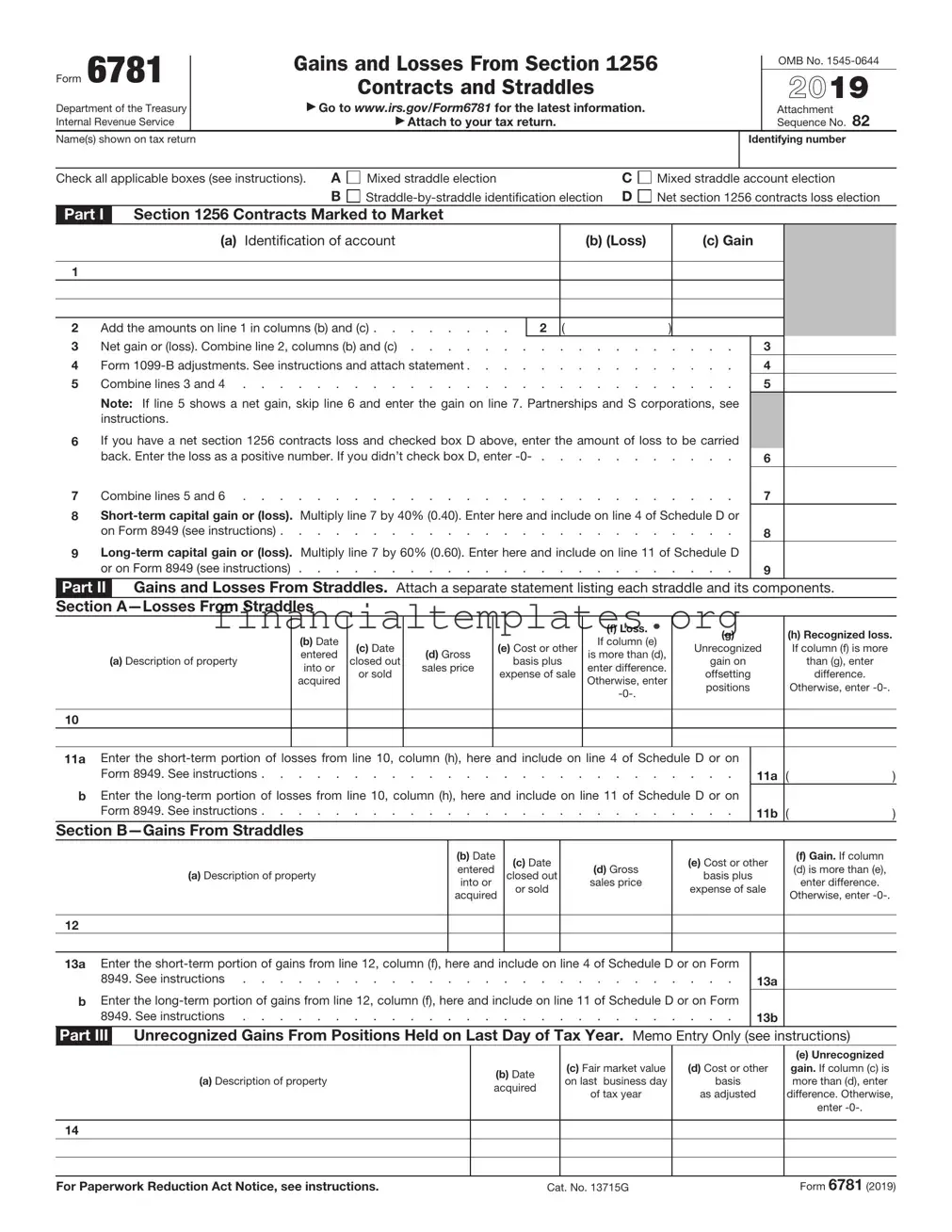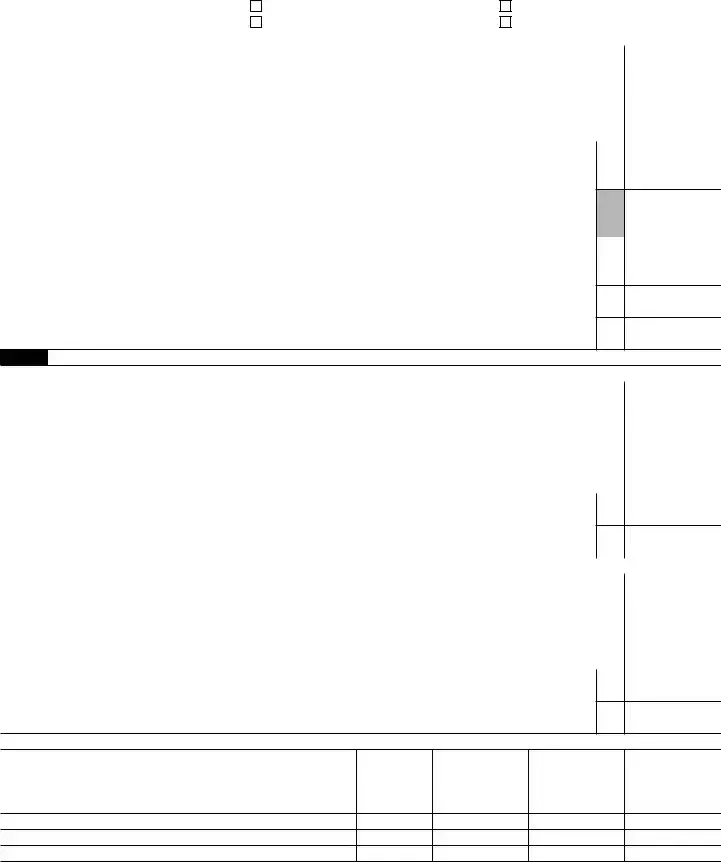Box D. Net Section 1256 Contracts Loss Election
If you have a net section 1256 contracts loss for 2021, you can elect to carry it back 3 years. Corporations, partnerships, estates, and trusts are not eligible to make this election. Your net section 1256 contracts loss is the smaller of:
•The excess of your losses from section 1256 contracts over the total of
(a) your gains from section 1256 contracts plus (b) $3,000 ($1,500 if married filing separately), or
•The total you would figure as your short-term and long-term capital loss carryovers to 2022 if line 6 of Form 6781 were zero. Use a separate Schedule D (Form 1040) and Capital Loss Carryover Worksheet (in Pub. 550) to figure this amount.
The amount you can carry back to any prior year is limited to the smaller of:
•The gain, if any, that you would report on line 16 of Schedule D (Form 1040) for that carryback year if only gains and losses from section 1256 contracts were taken into account; or
•The gain, if any, reported on line 16 of Schedule D (Form 1040) for that carryback year.
The amounts just described are figured prior to any carryback from the loss year. Also, the carryback is allowed only to the extent it doesn’t increase or produce a net operating loss for the carryback year. The loss is carried to the earliest year first.
Make the election by checking box D and entering the amount to be carried back on line 6. To carry your loss back, file Form 1045, Application for Tentative Refund, or an amended return. Attach an amended Form 6781 and an amended Schedule D (Form 1040) for the applicable years.
On the amended Forms 6781 for the years to which the loss is carried back, report the carryback on line 1 of that year’s amended Form 6781. Enter “Net section 1256 contracts loss carried back from” and the tax year in column (a), and enter the amount of the loss carried back in column (b).
Specific Instructions
Part I
Line 1
Include on line 1 all capital gains and losses from section 1256 contracts open at the end of your tax year or closed out during the year. If you received a Form 1099-B, Proceeds From Broker and Barter Exchange Transactions, or substitute statement, include on line 1 the amount from box 11 of each form. In column (a), write “Form 1099-B” and the
broker’s name. List separately each transaction for which you didn’t receive a Form 1099-B or substitute statement, or received a Form 1099-B that isn’t for your tax year.
If you are completing an amended 2021 Form 6781 to carry back a net section 1256 contracts loss from 2022 or a later year, report the carryback on line
1.Enter “Net section 1256 contracts loss carried back from” and the tax year in column (a), and enter the amount of the loss carried back to 2021 in column (b). See the instructions for box D for details.
Line 4
▲For information about how to ! elect to defer capital gain net income because you invested
CAUTION in a Qualified Opportunity Fund (QOF), see the Instructions for Form 8949. Don’t use line 4 to show the adjustment for a QOF-related deferral.
If the Form 1099-B you received includes a straddle or hedging transaction (as defined in section 1256(e)(2)), you may need to make certain adjustments, listed next. Attach a statement listing each of these adjustments and enter the total(s) on line 4.
•The section 1256 contract part of a mixed straddle, if you made any of the mixed straddle elections.
•The amount of the loss, if you didn’t make any of the mixed straddle elections or the straddle wasn’t identified as a mixed straddle and you had a loss on the section 1256 contract part that was less than the unrecognized gain on the non-section 1256 contract part. If the unrecognized gain is less than the loss, enter the unrecognized gain. Use Part I for a loss on the disposition of one or more positions that are part of a mixed straddle and that are non-section 1256 positions if no disposition of a non- section 1256 position in the straddle would be a long-term capital gain or loss and the disposition of one or more section 1256 positions in the straddle would be a capital gain or loss.
•The section 1256 contract part of a hedging transaction. The gain or loss on a hedging transaction is treated as ordinary income or loss. See Pub. 550 for details.
Line 5
Partnerships enter the amount from line 5 on Form 1065, Schedule K, line 11. S corporations enter the amount from line 5 on Form 1120-S, Schedule K, line
10.Lines 6 through 9 in Form 6781, Part I, don’t apply to partnerships or S corporations and are left blank.
Line 6
See the instructions for box D.
Line 8
If you are not deferring any of this
amount due to an investment in a QOF, include this amount on Schedule D (Form 1040), line 4; or on Schedule D (Form 1041), line 4. If you are deferring any of this amount due to an investment in a QOF, follow the instructions in the next paragraph.
For other returns, enter it in Part I of a Form 8949 with box B checked (if you received a Form 1099-B or substitute statement for every transaction included on line 1) or box C checked (if you can’t check box B). Enter “Form 6781, Part I” on line 1 in column (a). Enter the gain or (loss) in column (h). Leave all other columns blank.
Line 9
If you are not deferring any of this amount due to an investment in a QOF, include this amount on Schedule D (Form 1040), line 11; or on Schedule D (Form 1041), line 11. If you are deferring any of this amount due to an investment in a QOF, follow the instructions in the next paragraph.
For other returns, enter it in Part II of a Form 8949 with box E checked (if you received a Form 1099-B or substitute statement for every transaction included on line 1) or box F checked (if you can’t check box E). Enter “Form 6781, Part I” on line 1 in column (a). Enter the gain or (loss) in column (h). Leave all other columns blank.
|
▲ |
If you held a qualified |
|
! |
|
investment in a qualified |
|
opportunity fund (QOF) at any |
|
CAUTION |
time during the year, you must |
|
|
file your return with Form 8997. See the Instructions for Form 8997 for more information.
Part II
Use Section A for losses from positions that are part of a straddle. Generally, a loss is allowed to the extent it exceeds the unrecognized gain on offsetting positions. The part of the loss not allowed is treated as if incurred in the following year and is allowed to the same extent. However, a loss from a position established in an identified straddle after October 21, 2004, isn’t allowed. Instead, the basis of each offsetting position in the identified straddle that has unrecognized gain is increased by the amount of the unallowed loss multiplied by the following fraction:
The unrecognized gain (if any)
on the offsetting position
The total unrecognized gain on all positions that offset the loss position in the identified straddle
For more details, see Pub. 550, chapter 4.
Use Section B for gains from positions that are part of a straddle.



